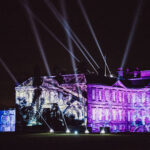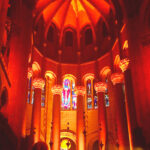Every winter, we see videos of some amazing large-scale Christmas light shows that take place. We see houses adorned with a million sparkling lights. Projection mapping on houses mixed with choreographed lighting. I’ve seen live animals, moving lights and trucks decked out with lights. But the Granddaddy of all of them takes place every year at Fred Loya’s house and grounds in El Paso, Texas.
For the tenth year in a row, Loya has upped the ante. Not satisfied to stay put with last year’s show, he adds to the celebration each year. In his own words, “This is not just a simple light show… this is a lighting event.” Most of us sit there and gasp while watching the show, but our technical brains just keep thinking, “How in the world did they do that?” Well, you put up lights and structures everywhere. Get 30 volunteers to amass 800 hours in build time, and then you bring in the master, Esteban.
400,000 Bulbs, but No Console
Esteban De La Torre is one of the hottest young programmers. If you have walked by an Elation Lighting booth at a trade show in recent years, you have seen his work. He is a full-time employee of theirs who can seemingly do anything with a lighting desk. But what makes this whole Christmas Light Extravaganza interesting is that he does not use a lighting console to control the 400 universes and 400,000 light bulbs he has to work with. He uses computers, software, only 30 dimmers and his brain.
De La Torre was raised in El Paso, Texas. Ten years ago, he found himself employed as a lighting technician with HB Stage Productions (hbstageproductions.com). Fred Loya, a prominent insurance businessman with companies all over the Southwest, came to them with a request to design and execute a big Christmas light show. As Esteban puts it, “We came up with some ideas and a game plan on what we could do. Then we pitched it to him thinking that he would never go for it with the expenses. But he surprised us by telling us to go for it. Of course then we had to figure out a way to pull it off.”
Ten years have passed, and Esteban resides in Long Beach, CA these days. He cannot come in to tech the show anymore, relying instead on Erick De Nava, Fred’s IT guy, to help coordinate the setup. It’s become easier lately as many lights stay up all year. But they still need to be wired, addressed and, of course, programmed. The show lasts eight minutes and is played several times on the hour during weekend nights. An estimated crowd of 3,000 spectators shows up for each performance in this neighborhood. Over the years, Loya has purchased several of the surrounding houses so as to not bother the neighbors. In fact, he uses one of them to serve hot cocoa and warm cookies to all who care to imbibe once the show is over.
This year, the event was filmed using drones hovering over the area. This captures the massive area. But what startled me is that there are really only a handful of moving lights on site. Those were Elation Platinum SBX hard edge fixtures, which De La Torre spec’d because, “I had that bright tight beam when I wanted it, and I could also use the custom holiday gobos we got from Apollo Design to show things like Santa’s face and snowflakes on the house.” The only other theatrical lights were the Elation Elar Tri Flood fixtures, which were used to throw color on the two houses on site. There were 100 circuits of practical light bulbs requiring 30 dimmers for the angels, reindeer, and other set pieces, but other than that, it was all strings of Christmas tree lights.
Across the front perimeter of the house is a fence. While watching the video captured by the drone, I could swear it was one big curved video wall. But it’s just strings of lights. In the far right back yard corner, there appeared to be another large video wall playing content. But that was “just a row of cypress trees,” according to Esteban. “A tech with a lift hung hundreds of strings vertically to create a low-res wall of sorts.” On the other side of the property is a gigantic stack of boxes piled up high like a pyramid of sorts. Each box is illuminated by an LED source, giving Loya another set piece in his toy box.
On-Site Programming
De La Torre was on site for a week, programming from 6 p.m. until 4 a.m. daily. He estimates there are 2,000 lighting cues in his eight-minute presentation. He relied on two things, CompuShow software (distributed nowadays by Elation) and a Madrix system (distributed by Inner Circle in the U.S.).
Esteban has been using CompuShow for 10 years on this job. It’s system where the programmer can cue his lights and easily drop these cues onto the timeline that will sync the cues to the music in time code. This software controls the moving lights and dimmers. Because of the 400 universes of RGB LED strings of bulbs, he uses the Madrix system to pixel-map all of them.
“What I did is set up a system where the different structures are actually treated like video surfaces. For example, each palm tree is draped in LED bulbs and is treated as a separate surface. The front fence is another,” states the LD. “There are two PC-based computers used to run the Madrix, because they exceeded the DMX universes allowed. Another PC ran the CompuShow. The CompuShow computer spits out two DMX streams of signal. One goes to the Madrix software through an Enttec device to cue that, while the other goes back to the movers and dimmers.” The Madrix system itself spits out sACN (architectural network protocol similar to Art-Net) which, feeds all the LED. Once Esteban writes all his cues on the Madrix system, he can easily adjust the timing by sliding them along the timeline.
ABC broadcasts a winter reality show called The Great Christmas Light Fight that featured a different location with a nice show each episode. It was interesting to watch in 2014, with home displays vying for bragging rights and a $50K prize awarded by those judging the spectacles. But when the Loya house was featured, it was an instant “Game-Over” moment, as the display was just over the top. And although that $50K prize could have gone toward even more twinkly Christmas lights — and hot chocolate for visitors — it was earmarked for charity instead.
For more photos go to http://www.prolightingspace.com/photo/albums/loya-house-holiday-light-show


